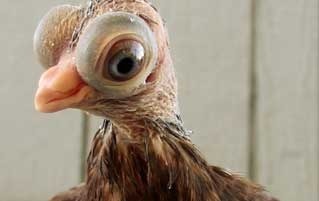The 7 Most Horrifying Pets We've Bred Into Existence

After hundreds of millions of years of evolution, our world was fully stocked with beautiful, strange, efficient animals well-suited to one task: surviving. Then humanity came along, spent a couple years dicking around with breeding, and ruined everything. Here are the abominations we have unleashed:
Werewolf Cats

The Lykoi was created for people who really want to get a cat and a diseased vampire bat, but only have room for one pet. The Lykoi may look like shitty '80s special effects trying to depict a werewolf changing forms, but that's intentional. Its sparse, patchy coat is due to a rare genetic anomaly.

The gene variant responsible for the mangy taint look wreaks havoc with the cats' hair follicles, leaving them unable to produce and/or maintain the soft fur that normally makes cats appealing. The scattered spikes of hair that do manage to proliferate from the animal's leathery skin give it the appearance of a miniature Benicio Del Toro in that werewolf movie, whose discussion is best left to the annals of history.

Fortunately, these cats don't appear to suffer from any adverse health effects so far, though geneticists and veterinarians warn that potential problems might not manifest themselves until the animals are 6 or 7 years old. And since the Lykoi cats are a recent invention, breeders are currently holding on to a lit stick of genetic dynamite and hoping it's a dud.

Damascene Goats

This is the aftermath of a botched reconstruction surgery after one family's beloved pet goat accidentally ate a land mine. Or else it's the pinnacle of years and years of carefully regulated breeding. Native to Syria, Damascene goats are also called Shami, Baladi, and Aleppo. You know what else they're called? Gorgeous. A Damascene goat just so happened to win the title of most beautiful goat at a competition in Riyadh, Saudi Arabia. That's a real thing, and this is a real beauty-contest winner:

Primarily raised for their milk, Damascene goats have been around for centuries and have made numerous cameos in Arabic literature and folklore, in which they are praised for their "special character, striking characteristics ... and nobility."

Pictured: Nobility. No nose, either.
Obviously, it wasn't nature who decided that looking like a hair-lipped sock puppet was the way to go; humans and their selective tinkering can take full credit for this masterpiece. Sure, it can't be easy to eat with a wadded-up baseball mitt for a face, but how can one condemn a little harmful genetic manipulation when the end product is something so breathtakingly magnificent?



Picasso drew one once and it came out looking completely normal.
Meishan Pigs

Taihu pigs come from China -- more specifically, Lake Taihu, located among the Yangtze River Delta's lower branches. One notable strain is the Meishan, which has been gaining some serious traction among pig ... fanciers? The Meishan pig was brought to America through a collaborative effort between the University of Illinois, Iowa State University, and the USDA -- just in case you'd like to direct your ire toward a specific entity.

The pigs reach sexual maturity two-and-a-half to three months after birth, have a long reproductive lifespan, and a large litter size (up to 16 piglets). Which all combines to make the Meishan among the most prolific sex-pigs in existence. Just try to keep it in your pants, lady-pigs.

This rapid-fire reproductive rate is the main reason the pigs were imported, as farmers salivated at the prospect of swine that multiply like rabbits. However, it didn't pan out because the Meishan stubbornly produce excessive amounts of body fat. Even by American standards the meat is too fatty, and most people prefer much leaner cuts. Although, hell, maybe slap one between two Krispy Kreme donuts and we'll be interested.

Gibber Italicus Canaries

This is the Gibber Italicus canary. It may surprise you to find out that it is neither sick, nor a baby skeksis from The Dark Crystal. There's actually nothing wrong with this bird whatsoever, beyond the moral level, of course. This is exactly how Italian canary enthusiasts meant for it to look. Their motivations are as unknown as the results are unsettling. One can only assume some breeder was deeply, deeply wronged by canaries somehow, and this is his twisted revenge on the whole species. Here's one sketching out in his cage like he just saw his face in the mirror for the first time.
It's basically the crackhead of the avian kingdom.
These canaries have been "closely inbred," and their plumage is best described as "scanty," but at least the exposed breastbone and lack of feathers on their spindly thighs advertises to any predators that eating them would surely be more effort than it's worth.

Guinea Pig Variants

What you're looking at there is called a skinny pig. Not because they're particularly svelte, obviously, but because their fur has been completely bred off of them, leaving nothing but exposed skin and a state of perpetual embarrassment. Skinny pigs usually have a smidgen of fur, like the one above does on its feet and face. So it's not quite a Baldwin, which is the rarest of all Guinea pigs and is completely hairless.
Like many good horror stories, this one begins with a mutation that occurred in a laboratory. Soon, however, "fanciers" got ahold of the rodent-that-should-not-be and started vigorously cross-breeding them into ever more repugnant iterations.


The guys you see above are called werewolf skinnies, which is what happens when cross-breeding results in a haphazard combination of hirsute and nude. We sincerely apologize for any traumatic flashbacks you may have to the YMCA changing room.

Lifelong puberty hair -- way to finally bring the nightmare to life, humanity.
Some breeders have gone in the exact opposite direction, encouraging hair growth over subsequent generations until they wind up with something like the Texel Guinea pig, which looks like a wig holder in Sarah Jessica Parker's dressing room.

They also have a strain called the Peruvian satin, whose silky luxuriance is matched only by its complete inability to run away from anything without tripping over its own fur.

"Good hair day? Try good hair life."
There's also the silkie, whose coat grows so quickly that you have to shear it as if it were a freaking sheep, lest it consume your house like a tribble invasion.

Poitou Donkies

This unwashed ass is a Poitou donkey. The breed is from France, and even without the mass of ropey grime-locks that passes for a coat, they're some of the world's largest donkeys. The gloopy, sludgy fur has been a part of their physical make-up since the early 1700s, and the donkey itself is "highly prized" for its hard-working nature. Which is understandable: what you lack in looks, you gotta make up for in other ways.

In 1977 a survey found that there were only a few Poitous left on Earth, so concerned donkey lovers rallied to bring the breed back from the verge of extinction by creating a "studbook," so that "breeding liaisons could be arranged." In essence, a little black book for donkey one-night stands. Thanks to prearranged dreadlock-donkey fuck sessions, today there are around 1,000 of these pinata-accurate suckers around.

Budapest Pigeons

We've already shown you a few of the more egregious ways that breeders have been deep-dicking pigeon DNA, but there's one variety in particular which seems to be designed solely as a challenge to Mother Nature's decency.

Not that Mother Nature was especially decent to begin with.
A lot of birds look like a ball sack with a head when they're chicks, but the Budapest pigeon takes the ugly all the way into adulthood. Also known as Budapest Short Face Tumblers, these frog-eyed monstrosities were developed in the early 1900s by the Poltl brothers of Hungary. Their deformations mean they require hand-feeding when they're babies, in case you're wondering if having your head be 75 percent eyeball has any adverse effects.

Oddly enough, tumblers are great fliers, able to stay in the air for up to five hours at a time and reach great heights. Whether this is because they're simply more comfortable in the sky, up away from the screams and judgment of the other birds, or if it's just a constant, futile attempt to hurl themselves into the sun is open to debate.
E. Reid Ross is a columnist at Man Cave Daily. You can also follow him on Twitter.
For more reasons Mother Nature wants us extinct, check out 6 Great Products For Making Your Pet Hate You. And then check out 21 Ways Life Would Change if We Could Understand Animals.
